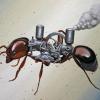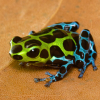Hello,
I heard from a lot of people from my ant community about sudden deaths of queens of already founded colonies once they reached 30-70 workers. And I never figured out what caused such a high death rate.
Those people told me that it started by them losing their honey pot workers (repletes) one after the other, even though food was enough. Then the queen suddenly died and a few workers stayed behind. I am still suprised what their mistake was.
I also once kept a Myrmecocystus mendax colony that had about 42 workers + 5 honey pot workers (repletes) and reached almost 1/2 year of age. I had them under a temperature of 77-79 °F and they did just fine for months. Suddenly 3 repletes died then 2 weeks later the queen. I never understood why because I changed literally nothing. I fed them insects like small Blauptica dubia roaches, small crickets, mealworms, sugar water, honey water. They literally had nothing missing, even a small farm was offered that they never planned to move into, maybe the colony was too small yet?
Other people had problems too.
I got some informations how those people kept their colonies and the answers were a bit similar actually, except the nest types. 1 Myrmecocystus mendax was kept with 30+ workers + brood in a test tube soon to be moved out with a temperature of 78 °F
1 Myrmecocystus navajo had over 70 workers and was kept in a Ytong(celluar concrete) nest and had about 78 - 82 °F, the nest that he had was always kept a bit moist but not enough to cause condensed water.
1 Myrmecocystus mimicus kept in a Ytong Nest between 76 - 80 °F, nearly the same as the colony above. He lost the colony after 6 months.
Many more different keepers lost their colonies already after the first worker generation 8-10 workers also for unknown reasons.
I am soon getting a Myrmecocystus navajo and I really want to be the first in my community to be successful and make it to a 300 workers+ colony. Anyone ever kept a colony for more than 1 year maybe even 2?
What is the right way to have success with Myrmecocystus to have a colony that can live with you for many years? What nests do you use? How is the temperature and humidity? Do you keep the chambers very wet? slightly wet? almost not wet? I saw people on youtube keeping them in a dirt box nest, I am almost tempted to also use a dirt box nest or to make my own ant Farm with a soil + sand mixture.
Any advice or warning to give to a Myrmecocystus beginner? I kept all kinds of complicated and difficult to keep species and raised them to large colonies, including Paraponera clavata, Neoponera apicalis, Messor minor, Atta cephalotes (bicolor),exotic camponotus species, etc.
So what was your way to success anyone had a colony that reached more than 1 year of age and above 200 workers? I am happy for any answers and advices you can give to me and maybe some others here that ready my post and consider keeping honey pot ants.
Greetings,
Marcel
















